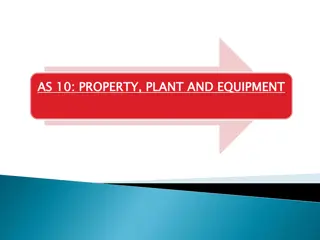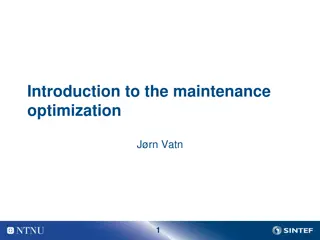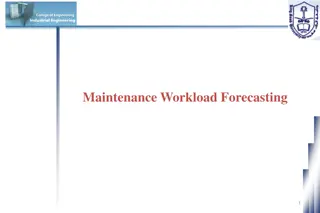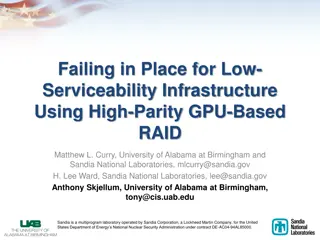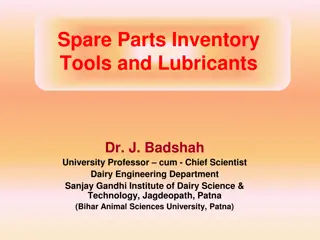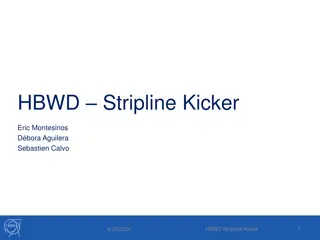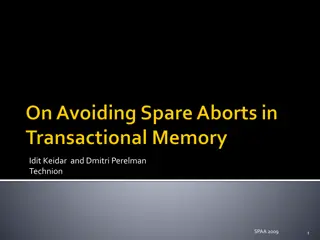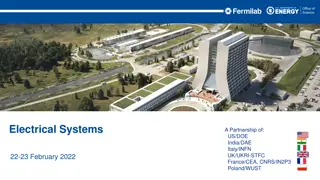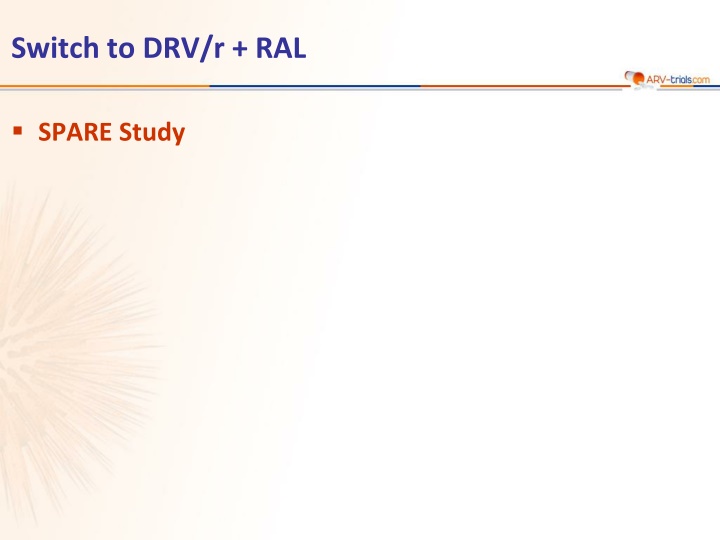
SPARE Study: Switching to DRV/r + RAL in HIV Patients
The SPARE study involved switching from LPV/r + TDF/FTC to RAL + DRV/r in HIV patients with preserved eGFR. Results showed no significant increase in renal function improvement but favorable viral efficacy. Limitations included a small sample size and self-reported adverse events in an open-label design.
Download Presentation

Please find below an Image/Link to download the presentation.
The content on the website is provided AS IS for your information and personal use only. It may not be sold, licensed, or shared on other websites without obtaining consent from the author. If you encounter any issues during the download, it is possible that the publisher has removed the file from their server.
You are allowed to download the files provided on this website for personal or commercial use, subject to the condition that they are used lawfully. All files are the property of their respective owners.
The content on the website is provided AS IS for your information and personal use only. It may not be sold, licensed, or shared on other websites without obtaining consent from the author.
E N D
Presentation Transcript
Switch to DRV/r + RAL SPARE Study
118 SPARE Study: switch to DRV/r + RAL Randomisation* 1 : 1 Open-label Design W96 Age 20 years HIV+ N = 28 DRV/r qd + RAL bid HIV-1 RNA < 50 c/ml > 15 weeks On LPV/r + TDF/FTC No prior virologic failure on PI/r- or INSTI-containing regimen eGFR (CG) > 60 mL/min HBs Ag negative Continuation of LPV/r + TDF/FTC N = 30 * Randomisation was stratified based on baseline body weight of 60 kg Objective Primary endpoint: proportion of patients with > 10% improvement in eGFR at 48 weeks from the baseline calculated with the CG equation Secondary endpoints: changes in per protocol renal tubular markers from baseline to week 48, proportions of patients with HIV-1 RNA < 50 c/mL at W24 and W48 (per protocol and ITT) Nishijima T. PLOS One 2013;8:e73639 SPARE
SPARE Study: switch to DRV/r + RAL Baseline characteristics (median), and disposition DRV/r + RAL N = 28 Continued LPV/r + TDF/FTC N = 30 Age, years 44 39 Female 0 3% CD4/mm3 549 456 eGFR (Cockroft-Gault), mL/min 119 108 Duration of TDF use, weeks 124 163 Discontinuation by W48 N = 4 N = 2 Nishijima T. PLOS One 2013;8:e73639 SPARE
SPARE Study: switch to DRV/r + RAL Endpoints by W48 DRV/r + RAL N = 28 Continued LPV/r + TDF/FTC N = 30 Primary endpoint : Improvement in eGFR > 10% increase in eGFR (CG formula) 6/24 3/28 (p = 0.27) Mean % improvement from baseline 5.4% - 3.3% Differences in mean % improvement (95% CI) - 8.7% (- 18.2 to 0.8) (p = 0.071) HIV RNA < 50 c/mL Per protocol W24 / W48 96.2% / 100% 96.7% / 100% ITT W24 / W48 89.3% / 85.7% 96.7% / 96.7% Safety, N Discontinuation for AE 2 0 Grade 3-4 laboratory abnormalities or symptoms 4 4 Nishijima T. PLOS One 2013;8:e73639 SPARE
SPARE Study: switch to DRV/r + RAL Conclusion Switching LPV/r + TDF/FTC to RAL+ DRV/r did not significantly increase the proportion of patients who showed >10% improvement in renal function among those with relatively preserved eGFR. However, the switch improved urinary 2 microglobulin, suggesting that discontinuation of TDF might be beneficial in the long-term RAL +DRV/r showed favorable viral efficacy in patients with suppressed viral load Limitations Small sample size Adverse events self-reported, open-label unblinded design Nishijima T. PLOS One 2013;8:e73639 SPARE







